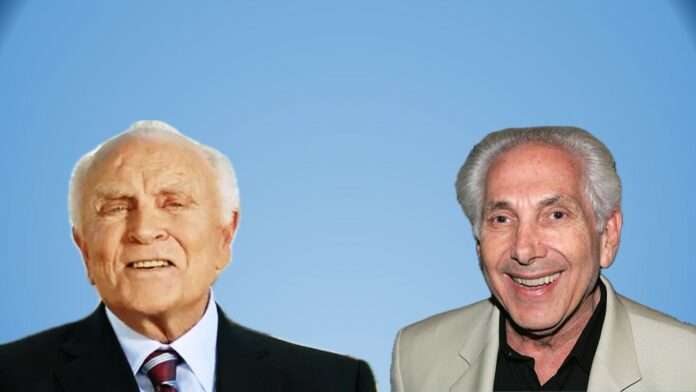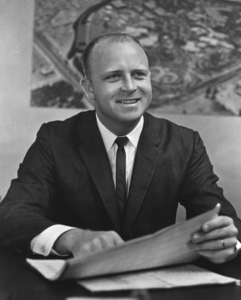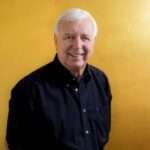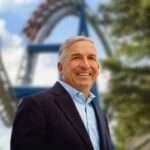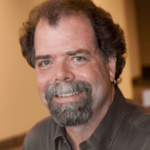Curated by Joe Kleiman
As we close out the year, we pay tribute to two influential pioneers of the themed entertainment community whom we recently lost – long-time Disney theme park executive and operations specialist Dick Nunis, who set the standard for guest-centric operations, and Marty Krofft, who with his brother Sid established one of the most famous puppeteering companies of the late 20th Century.
DICK NUNIS
Dick Nunis, who passed away December 13, 2023 at age 91, approached theme park operations by looking at it as more than just structures and attractions. He understood the need for the human connection and that all the architecture, the attraction design, the dining and shopping were able to be enjoyed by guests because of the positive interface with cast members. With Van France, he developed the Disney University training program for cast members. In 2022, during a D23 Q&A session, Nunis said, “One of the phrases we used a lot in training—‘the magic mirror of your smile’—that was my phrase.” According to his wife Mary, that meant that “you smile and ‘the mirror’—in this case another person—smiles back.”
By 1961, Nunis had become Director of Park Operations at Disneyland. In 1971, he became the Executive Vice President of both Walt Disney World and Disneyland. His role would expand when, in 1980, he was named President of Disney’s Outdoor Recreation Division, overseeing the expansion of the Walt Disney World Resort with the additions of Epcot Center and the Disney-MGM Studios, along with a slew of hotels, waterparks, and shopping and dining options.
Nunis was well-known for pushing his staff to meet goals and deadlines, but foremost, he instilled a belief in the company that people made the difference, that a single interaction could transform a theme park visit into an experience. It’s a philosophy that has carried over to theme parks, attractions, and hospitality operations worldwide.
Nunis interacted with all divisions of the Disney company involved in theme park design and operation during his career. We are grateful to entertainment designer Ron Miziker, former Imagineer Rick Rothschild, and former Disneyland Resort President Matt Ouimet for sharing their memories:
Ron Miziker, Founder/Creative Consultant, Miziker Entertainment Group
Ron Miziker is a live entertainment specialist with 50+ years’ show experience. In 1971, he joined Disney, where he served as an Entertainment Producer and Director, responsible for a number of opening ceremonies, parades, and special events, including playing a key role in the development of the Main Street Electrical Parade. In 1983, he moved on to the Disney Channel, to take on the role of Vice President of Original Programming. Following his time at Disney, Miziker founded and helmed Miziker Entertainment for thirty years, successfully completing more than 500 projects for over 200 clients in 24 countries. The company he founded remains a leader in live entertainment and spectacles, led by Ryan Miziker, Charlotte Huggins, and Sean Chung. In 2015, Miziker was honored by the Themed Entertainment Association (TEA) with the Buzz Price Thea Award for a Lifetime of Distinguished Achievements.
“His leadership enabled Walt Disney World to open on schedule”
I was the Director of the Live Entertainment division during the last couple of months before the opening of Walt Disney World. Like all the other directors – such as for merchandise, operations, food and beverage, etc. – we were required by Dick to do site walk-throughs with him when he decided to have one… which was frequent. We’d spend half a day or more as a group tramping through every part of the park during those final days of construction.
These treks were hot, dirty, buggy, and intense. Along the way, Dick would stop and ask the appropriate director questions like, “Why isn’t the equipment installed in this facility yet? You said three days ago it was being installed and I see nothing! I want installed by tomorrow! If it is not here, I’ll get someone else to get it here!” On a walk-through two weeks before opening, we were walking in a few inches of water along the waterway of the Jungle Cruise as it was being filled for the first time. My beeper went off. It was for my wife’s message that she was being rushed off to the hospital to deliver our second child, and to come as quickly as I could. I looked up and Dick was giving demands and pointing in every direction. I looked down and the water was now up to my ankles. Dick paused. I took this opportunity to say that I had an emergency and needed to leave immediately. It caused a verbal explosion. No one leaves Dick’s walk-through. When he paused, I jumped in with my reason for leaving. Dick stood still. Stared at me for a second or two and said, “Why in hell are you just standing there? Get the hell out of here and go to your wife! But be back in two hours.”
That was the kind of person Dick was. Demanding and dedicated to getting the enormous project he loved completed on time; yet very caring when required. That is why I believe he was truly a great leader and I respected him. I also believe that Walt Disney World would never have opened on time without Dick Nunis leading the charge.
Matt Ouimet
Matt Ouimet joined Disney in 1989, acting in a number of roles within the company. During his tenure at Disney, he served as Executive General Manager of Disney Vacation Club, President of Disney Cruise Line, and President of Disneyland Resort, where he oversaw the resort’s 50th Anniversary celebration. In 2011, he was named President of Cedar Fair Entertainment, a leading North American theme park and waterpark company, and became CEO in 2012. In 2017, Ouimet stepped down as CEO, but remained on the company’s board through 2023.
“Great guest experience became part of my professional personality”
Disney hired me to be the CFO of their real estate division, the Disney Development Company. This was during the latter years of Dick’s career. Internal political tensions were high between the various divisions and Corporate. For years, “gold footballs,” the windshield stickers that gave you all-property access, were only given to long-tenured cast members who ultimately achieved an executive role. But, under Michael Eisner, some of us got our footballs with no internal track record. Given this environment I was always plainly scared whenever it came to interaction with Dick. To his credit, he always treated me fairly, and only once threatened to “take me off his speed dial.” What is most important to share is that no one taught me more about the importance of delivering Disney-level guest experiences. It wasn’t just an intellectual lesson, it was one that became part of my professional personality. Dick truly created the foundation for the great guest experience Disney is known for.
Rick Rothschild, Chief Creative, FAR Out! Creative Direction
Rick Rothschild is a former Creative Director with Walt Disney Imagineering, where he lent his creative talent to such notable attractions as The American Adventure, Pleasure Island, and Soarin’ Over California. With his own firm, FAR Out! Creative Direction, Rothschild has advanced the flying theater and motion simulator genres with the FlyOver attractions found throughout North America and in Iceland, for experience company Pursuit, and the Bermuda Storm ship simulator experience at Chimelong Spaceship in Zhuhai, China, which was recently announced as the recipient of a TEA Thea Award. Rothschild is a Past President of the Themed Entertainment Association.
“Respect and kindness”
Early on in my work at Imagineering, I remember well a session with Dick where he rhetorically asked “Do you know the three reasons why our guests love Disney parks?”… to which he answered, “One…Our cast members are always friendly, helping to make sure our guests have a great experience. Two… Our parks are clean and always well maintained. Three… Oh, and then… there’s the attractions you here at WED (given when he said this was in the late ’70s) create for our guests.”
The order in which Dick presented these three reasons was extremely important to him… if you don’t first make the experience at a Disney park a personal, helpful, and friendly one, the rest of what is there for the guests to enjoy will be diminished. That goes along with guaranteeing that any day in the park feels as fresh and well appointed as opening day, guaranteeing an fully enjoyable experience of all that Imagineers create.
This was a simple message spoken by a fully devoted Disney guy that I carried with me through my career at Imagineering and to this day. Remembering who we are all working to bring joy and excitement to with all we create in themed entertainment and just how important treating them respectfully and with kindness is.
Thank you Dick! RIP
MARTY KROFFT
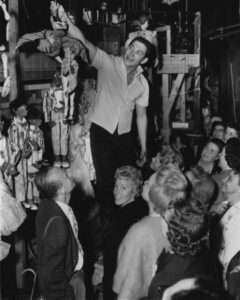
Marty Krofft, one-half of the puppetry powerhouse Sid and Marty Krofft, passed away November 25, 2023 at the age of 86. In 1958, he became assistant to his older brother Sid, creating the Krofft Theater, later renamed to Sid and Marty Krofft Productions. Marty would soon move on to manage the business with Sid overseeing the creative, a relationship similar to that between Walt Disney and his brother Roy. Though the partnership could be tumultuous at times, the company’s body of work brought significant innovations to the art of puppetry while remaining true to its roots, and influenced many creative designers over the years. The Krofft company performed at three world’s fairs (Seattle, New York, and San Antonio) and a number of theme parks, including Six Flags parks and Kings Island. We were privileged to speak with Marty’s brother Sid as well as former Krofft designer Jeremy Railton, who became a creative industry force in his own right.
Jeremy Railton, Senior Partner, Railton Entertainment Design
Jeremy Railton is a production and creative designer whose experience ranges from zoos to live theater, television productions, concerts (stars such as Barbara Streisand and Cher), and themed experiences, including TEA Thea Award recipient Crane Dance at Resorts World Sentosa. Railton is also a recipient of the Buzz Price Thea Award for a Lifetime of Distinguished Achievements. At the time that the Krofft puppets were performing at the various world’s fairs, there were twenty-three artists on payroll. “Jeremy was one of them,” shared Sid Krofft. “I interviewed Jeremy and hired him – he was extremely well qualified!'”
“The show went on”
After working for Sid and Marty Krofft for many years from the Atlanta park, Puff n Stuff, Donny and Marie, Pink Lady and many Saturday morning shows they treated me as a family member! It was always fun with a crazy ambitious energy about them. Sid and Marty ruled entertainment from the early seventies to early eighties.
When Pink Lady, a Japanese pop culture duo signed to do an NBC variety show the pilot was shot at NBC. As a welcome, and a way to break the ice for the two shy non English speaking singers, Marty thought it would be fun to give the girls a laugh. The sketch was brought to an end by the girls opening a door to see a huge Sumo wrestler! Marty suggested to his friend Billy Barty, a well know little person actor, that he dress up as a sumo wrestler and it would be a funny surprise.
It didn’t go well. The girls screamed when they opened the door and ran cowering to a corner of the set, literally shivering with fear! Evidently in their culture seeing a little person like that was very bad luck!! Almost a curse! But they recovered and the show went on!
Sid Krofft
“Take the lead.”
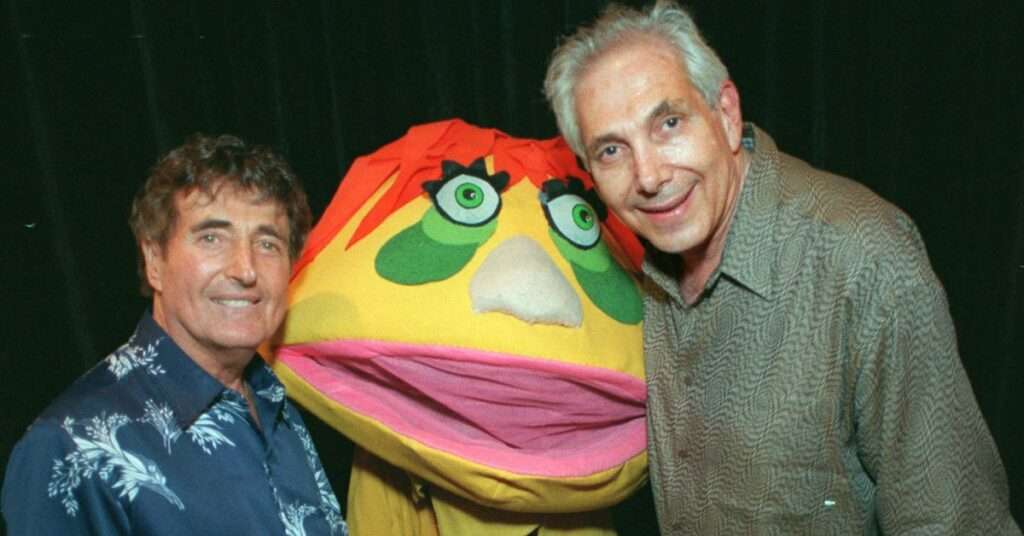
I didn’t really know my brother growing up. We came from a big family and I was on the road since I was ten years old. He was eight years younger.
At fifteen, I was performing on Broadway, then I followed that with tours of the States and Europe. I had a very adult puppet act opening for Judy Garland and Liberace. Did the Folies Bergere and the Lido in Paris, did a big show in London from about six or seven months, including a command performance for the Queen.
I had an assistant named Ray Arnett, who left me because he got a better job, so Marty joined me in 1958 when I was at the Flamingo in Vegas, to be my assistant. He had written in his yearbook that he wanted to be a puppeteer like his older brother and change his name to Krofft. Krofft was something I picked up as a showbiz name.
Marty was really the business end of the company. He was great at sales. He could sell anything – when he was young, he sold cars, and pendants at Yankee Stadium. It was a gift.
The Maître d’ at the Flamingo had saved enough money to open his own venue in Los Angeles. It was a restaurant, a club, and us, doing a T&A puppet show, the kind of entertainment I saw in the clubs in Paris.
This show, Les Poupées de Paris, was so popular that we were invited to perform it in a nine-hundred seat theater at the 1962 World’s Fair in Seattle. They built a theater for us and the girls came down from the ceiling and there was a 50-foot rotating stage and a fifty-piece orchestra. For the opening show, they ushered in Billy Graham, and that night he had a rally with 100,000 people and he told them, “Don’t go see the show called Les Poupées de Paris because the women there don’t wear bras.” We were invited next to the 1964 fair in New York, where we had an even bigger theater, with 1200 seats, but they made one caveat – the female marionettes had to wear bras until 5:00 p.m. After that, when the kids had gone home, the bras could come off.
At one point, we had 250 people in our factory. One day, in 1962, Marty and I are having lunch in the Polo Lounge with dancer Cyd Charisse and her husband Tony Martin and Walt Disney is in the next booth over. He comes over to say hi to Cyd and Tony and they introduce us to Walt. He says, “I’ve heard of you guys. In fact, I’m going to Seattle to see the fair before it closes. Can I give you some advice? You’re marketing yourselves as the Krofft Theater. Always put your name above everything you create because some day, it’ll be worth something.” I mentioned this to our publicist and he said, “Yeah, Krofft Theater means nothing, but I can sell two brothers.” That’s how we became Sid and Marty Krofft. Later, a lot of our employees moved on to work for Jim Henson. Everyone thought the Krofft puppets were Muppets. Marty met with Jim and told him the Walt Disney story and then Jim started putting his name on all his projects.
We did a lot of work for Six Flags. I used to run a lot and sometimes I’d join a pickup game of volleyball afterwards. One day, I start a game and a friend of mine tells me that he’s looking for new attractions for Six Flags parks. They were about to open a new park in Georgia, and that he would mention us to Angus Wynne, who owned the parks. I didn’t think much of it. Wynne had a competing show, a Broadway-style show, that played at the 1964 world’s fair. Our show was a success. His flopped. A few days after that game, I get word that Wynne wants to meet.
Our shows at the fairs were 50 minutes long. This Six Flags one was shorter – only 25 minutes, but it was the hit of the park. At the Georgia park, people were lining up for hours to see it.
We later had our own park, called the World of Sid and Marty Krofft, in downtown Atlanta, but it only lasted six months. When we agreed to the park, the city promised they’d clean up the downtown by the time we opened. They didn’t, so we didn’t get the traffic.
I was the creative guy. Marty handled the business end. He was the only person I had big arguments with. He wanted to cut our television budgets in half because that’s what the studio wanted. So when you watch our TV shows, like H.R. Pufnstuf, which actually started as a show we created for Coca-Cola at the 1968 San Antonio World’s Fair called Kaleidescope, you’ll see there are no sets. Everything was wood cutouts and paint. That only made our scripts and our performances that much stronger.
And it’s important for people to know this – a lot of people think our TV shows were for kids. They really weren’t. They were written for adults. A lot of our stuff was written by television writers who also worked on Star Trek.
The last words I said to Marty at the foot of the bed, and the nurse said he could hear me, was “Marty, it’s Sid. I’ll see you in my dreams.” Then he passed away.
Marty was my little brother, he was one of a kind. Everyone who met him experienced something very unique. Every single dream I had, he got it produced.
I tell people, “Everyone is so creative, every single person. If you stay focused on a creative thought, you’ll get it done. Tell everybody to go left, because everyone always goes right. Don’t follow the leader – take the lead.”
We didn’t always get along, but we were an incredible team, and we worked together in a big way. Marty was like a man of steel – he never gave up. People can learn from Marty – stay focused, never give up, and you’ll get it done.


